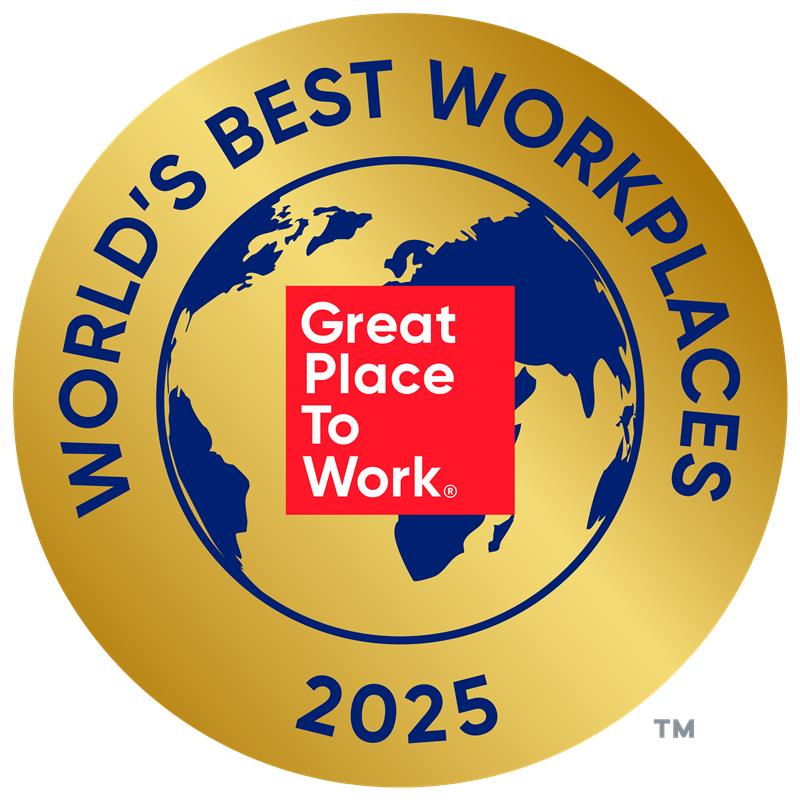
At Experian, we often say our people are our biggest superpower – and today, I’m thrilled to share that this belief has been recognised once again. Experian has been named one of the 2025 World’s Best Workplaces™ by Fortune and Great Place to Work® for the second year in a row.
This achievement reflects the culture we’ve built together – one that’s welcoming, inclusive, and rooted belonging. It’s a celebration of every colleague who brings their whole self to work, who lifts others up, and who powers opportunities for our clients, consumers, and communities.

We’ve made it our mission to create a workplace where everyone feels included, respected, and empowered. That’s why we’re proud to have earned top scores on the Corporate Equality Index and the Disability Equality Index, and to be recognised with the Outie Award for Workplace Excellence and Belonging.
These recognitions matter. But what matters most is how our people experience life at Experian. Whether it’s collaborating, innovating, or growing through world-class development of products, services and contributing to our communities, our culture is designed to help everyone thrive.
We’ve also made bold commitments to career development. Initiatives like Global Careers Week, the AI-driven performance coach Nadia, and the NextGen Forum – a global leadership development programme for emerging talent from across our regions – give our people the resources to take charge of their growth and build a “One Experian” mindset.
Being named one of the World’s Best Workplaces is a moment to celebrate but also a reminder to keep aiming higher. The world of work is evolving fast, and so are we. From embracing AI to enhancing our digital workplace experience, we’ll continue to push forward and listen to our people every step of the way.
Questions we will discuss:
- What does “retirement readiness” mean to you, and how can someone tell when they are financially ready to retire?
- Is there a magic number for retirement savings, and what factors should someone consider when setting a retirement goal?
- How can someone estimate their retirement expenses realistically?
- What are some common myths or misconceptions about how much money you need to retire?
- How should Gen Z, Millennials, and Gen Xers each approach retirement planning differently based on their stage of life?
- What are the biggest obstacles people face when trying to save for retirement, and how can they overcome them?
- How can you balance saving for retirement with paying off debt or supporting family today?
- What tools, calculators, or strategies can help people figure out if they’re on track for retirement?
- How can people prepare for unexpected costs or life changes that could impact their retirement plans?
- What’s one piece of advice you’d give someone just starting—or restarting—their retirement savings journey?
| Columns 1 | Column 2 | Column 3 | Column 4 |
|---|---|---|---|
| Row 1 Col 1 | |||
| Row 2 Col 1 | |||
| Row 3 Col 1 | |||
| Footer 1 | Footer 2 | Footer 3 | Footer 4 |

Credit Chat
Stretching your Dollars: Practical Tips to Cut Costs and Save More
February 5, 2025 3-4 PM ET
- What does “retirement readiness” mean to you, and how can someone tell when they are financially ready to retire?
- Is there a magic number for retirement savings, and what factors should someone consider when setting a retirement goal?
- How can someone estimate their retirement expenses realistically?

Greater transparency in buy now, pay later activity is key to helping consumers build their credit histories and supporting responsible lending. We have members of the military right now right out of high school and there’s not a lot of experience managing their own money. They’re quickly thrust into a place where they don’t have a support system to do that. We have members of the military right now right out of high school and there’s not a lot of experience managing their own money. They’re quickly thrust into a place where they don’t have a support system to do that. We have members of the military right now right out of high school and there’s not a lot of experience managing their own money. They’re quickly thrust into a place where they don’t have a support system to do that. We have members of the military right now right out of high school and there’s not a lot of experience managing their own money. They’re quickly thrust into a place where they don’t have a support system to do that. We have members of the military right now right out of high school and there’s not a lot of experience managing their own money. They’re quickly thrust into a place where they don’t have a support system to do that.
Experian North AmericaScott Brown, Group President, Financial Services

In the video and presentation, Craig Boundy, former CEO of Experian North America, discusses how big data is being used as a force for good. Good for consumers, good for business and good for society.He shares his perspective how Experian’s work in data and analytics has real-life applications. As part of this, he highlights how our business is predicated on the idea that Experian employees come to work every day to help society make better sense of the world by sifting through the information and coming up with solutions for real people, partners, governments and clients. Whether that helps consumers secure an affordable loan, understand their credit score, or protect their identity; or for a business to manage risk, help prevent fraudulent transactions, and to ensure they are marketing their products and services to the right consumers at the right time and across the right channels. As you will see, the force that is known as Big Data can be used for good and there’s still more we can do with it to drive growth and improve our economy. Big Data: The Force That’s Good for Consumers and Society from Experian_US

The following column was originally published in Adotas. Addressing the issue of identity management has become a top priority for marketers. The fact is that their customers are represented by dozens of identities – both known and unknown – in today’s digital world. According to new research published in our recently published 2015 Digital Marketer Report, linking identity data is now the #1 challenge for marketers around the world, up from fourth place just a year ago. Further, 89% of marketers report having challenges creating a single customer view. Why? Top reasons cited by marketers include poor data quality (43%), siloed departments (39%), and inability to link different technologies (37%). Brand marketers have an identity crisis Without a sophisticated approach to identity management, the concept of customer-centricity and data-driven marketing slips, like sand, through the fingers of marketers. Yes, they may have details around a specific customer on a given device or in a particular channel, but the holistic promise provided by identity data is lost; and with it the real potential of targeting, reaching and engaging digital audiences. To appreciate the nature of the challenge, it is helpful to understand its scale. According to our latest research, 84% of U.S. adults are digital. Seventy three percent own a computer, 58% a smart phone and 33% a tablet – percentages that will only increase with time. These devices will be joined by wearables (such as the Apple Watch), addressable television and the emerging world of the Internet of Things. Couple the explosion of devices with the number of email addresses, social media accounts, apps, website logins, cookies and other trackers and you have the ingredients for a full-blown identity crisis. Connecting the identity dots All of the data associated with these identities paint a rich, complex and complete picture of the user behind them. Connecting and managing these identity dots, however, is no small task. For everyone there are known identities (accounts you log into) and unknown ones (anonymous IDs based on web histories) and marketers need to appreciate and be able to navigate the differences. When linked and analyzed responsibly, identity information allows marketers to understand who we are, what matters to us and how to craft the most effective digital experience for all. This is what makes identity management such a critical issue. Good identity data provides marketers with three core capabilities: Identify – the ability to identify people across media channels, devices, access methods and applications using techniques including cookies, deterministic and probabilistic IDs and first party data. Link – the ability to link disparate data and profiles into a unified consumer view. Engage – the ability to use a deeper understanding of customers to better deliver better messages, optimize campaigns and measure performance. Identity Management is the foundation of Data-Driven Marketing For marketers to get the greatest benefit from their data, they need an identity management strategy that considers and addresses the following three things: Data Stewardship – preserving the value of the information, protecting the privacy of individuals and making it available for appropriate uses. Identity Resolution – having the ability to make connections between disparate known datasets and being able to infer connections between known and unknown identities. Technology-Current – maintaining the ability to effectively and compliantly collect, manage and act on digital identity-derived information across existing and emerging channels, platforms and devices. So what does this identity management approach look like in a real world campaign? A customer visits a brand website, uses its mobile app and “like” it on Facebook. The result is three discreet identifiers, two deterministic (the app and Facebook) but likely stored in separate systems and one statistical (the site visit). Appropriate data stewardship means all three data sets are stored and protected – and, perhaps most importantly – are accessible. Although a distinct identifier represents each of the three identities, linkage capabilities allow them to be resolved in a way that unites the data behind each of the three. Rather than treating each identifier as a separate individual, they can now be used to reflect different facets on a single person. With a now unified view, the marketer can begin to plan to reach their customers in more creative and effective ways. They can do a better job of executing cross-channel campaigns – and frequency capping on all devices and platforms. This provides a dramatically different experience for all involved. Why? Because not only does the marketer have a unified view of the customer, but the customer has a unified experience of the brand. Without an identity-driven approach to audience engagement and marketing, the customer will not be able to have a unified brand experience because the marketer can’t establish that unified view. Further, it allows marketers to make the most of their organization’s information assets, meet their customers where and when it makes the most sense and execute the most cost-efficient and effective campaign possible.

If you were to survey American consumers whether or not they would like to be their own boss and successfully run their own business, I would imagine that a good majority would probably say yes. There is something empowering about the thought of setting your own hours and controlling your own destiny, but many people don’t actually take the steps to make that dream a reality. However, during the height of the recession and shortly thereafter, many consumers were forced to take the plunge and start their own business as a way to generate a source of income. As a result, entrepreneurism skyrocketed. While some struggled, others succeeded. But how have entrepreneurs fared in the post-recessionary period? As a way to better understand the start-up environment post-recession, Experian conducted an analysis on small business start-up trends from 2010-2014. Interestingly, the number of startups has decreased nearly 45 percent since 2010 – most likely due to a slowdown following the influx of businesses started during the recession. That said, the trend has become somewhat stable over the past few years. While the drop in the number of start-ups may appear discouraging, it isn’t necessarily a cause for concern. As we see employment rates trek higher, and the Gross Domestic Product climb, we’ve been able to experience an improved economy. This also means that fewer consumers feel the need to startup new businesses out of necessity. Furthermore, we’ve also seen that the start-ups that opened in 2010 have grown in size by nearly 29 percent, or added 1.2 employees in the four years that the analysis tracked. Additionally the data showed that of the businesses started in 2010, approximately 57 percent of them are still in business. The analysis also found that entrepreneurs tend to favor the restaurant industry when starting a new venture, as 10.6 percent of start-ups were in the food and drink business. Restaurants were followed by personal services, miscellaneous retail, business services and general contractors. Interestingly, the restaurant and personal services industries were also the two with the highest rates of failure at 9.2 percent and 8.1 percent, respectively. Gaining insight into the data and trends of small business start-ups can be extremely beneficial to new entrepreneurs and lenders, alike. On one hand, entrepreneurs can use the data to understand what types of businesses are the most popular, and which are most prone to failure. On the other, lenders can use the data to determine which start-ups present the least amount of risk and when it is most beneficial to market to prospective borrowers. Small businesses are the life blood of the economy, and their continued success is paramount to a well-functioning financial system. With the power of data and insights at their side, lenders can make better decisions when looking to fund new ventures and entrepreneurs become more empowered to take that leap and turn their dreams a reality. Overall, a winning recipe that any restaurant owner can get behind.
2024 Best Place to Work for Disability Inclusion


